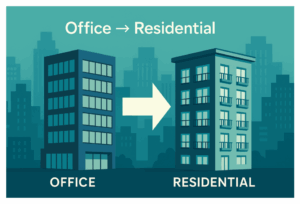In commercial real estate, understanding the Weighted Average Lease Term (WALT) is crucial for assessing the stability and risk profile of an investment. A WALT in the range of 5 to 7 years is generally considered good, indicating stable rental income and low vacancy risk. This article explores why WALT matters, what constitutes a good WALT, and strategies to improve it.
Why WALT Matters
WALT measures the average remaining lease term across all tenants in a building, weighted by the rental income each lease generates. A higher WALT suggests longer-term leases and more stable income streams, making the property more attractive to investors. Conversely, a lower WALT may indicate higher turnover rates and potential vacancies, increasing the investment risk.
What is Considered a Good WALT?
A good WALT varies by property type and market conditions. Generally, a WALT of 5-7 years is considered strong for commercial properties. This range indicates that tenants have committed to medium- to long-term leases, providing predictable and secure cash flows for the property owner.
Property Type and Market Conditions
The definition of a good WALT can vary depending on the type of property and the market conditions:
- Office Buildings: Ideal WALT is 5-10 years, indicating long-term corporate commitments.
- Retail Properties: Ideal WALT is 5-7 years, suggesting a stable mix of anchor and smaller tenants.
- Industrial Properties: Ideal WALT is 3-5 years, balancing stability and flexibility.
Factors Affecting WALT
- Tenant Mix and Lease Terms: A diverse mix of long-term and short-term leases can impact the overall WALT.
- Market Conditions: Strong economic conditions and high market demand typically result in longer lease commitments.
- Property Location: Prime locations often attract tenants willing to sign longer leases.
Strategies to Improve WALT
- Proactive Lease Management: Regularly negotiating lease renewals and extensions can enhance WALT. Offering incentives for longer commitments is a common strategy.
- Attracting Long-Term Tenants: Targeting tenants who prefer longer leases, such as established corporations, can improve WALT.
- Enhancing Property Appeal: Upgrading amenities and services can make a property more attractive to long-term tenants, indirectly boosting WALT.
Impact on Property Valuation
A strong WALT can significantly enhance a property’s valuation. It suggests lower risk, leading to lower capitalization rates and higher property values. Investors are more likely to invest in properties with longer, stable income streams.
Conclusion
A WALT of 5-7 years is generally considered good in commercial real estate, indicating stable rental income and low vacancy risk. Understanding and optimizing WALT is essential for anyone involved in commercial real estate, from property managers to investors, as it directly impacts the stability, risk, and value of the investment.




